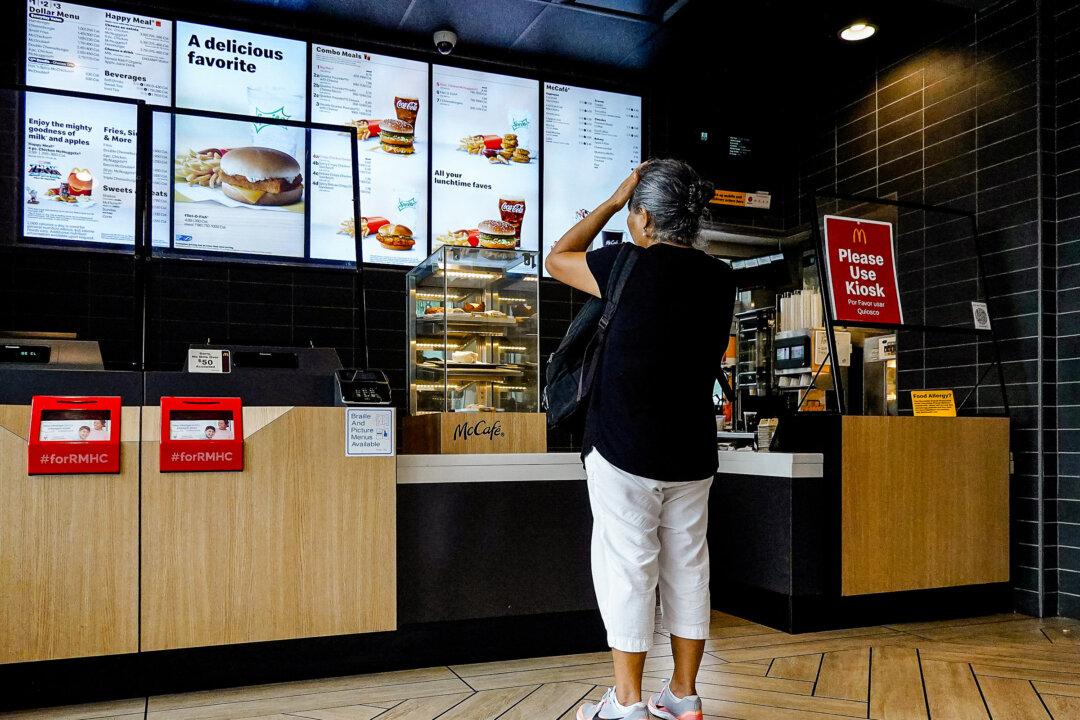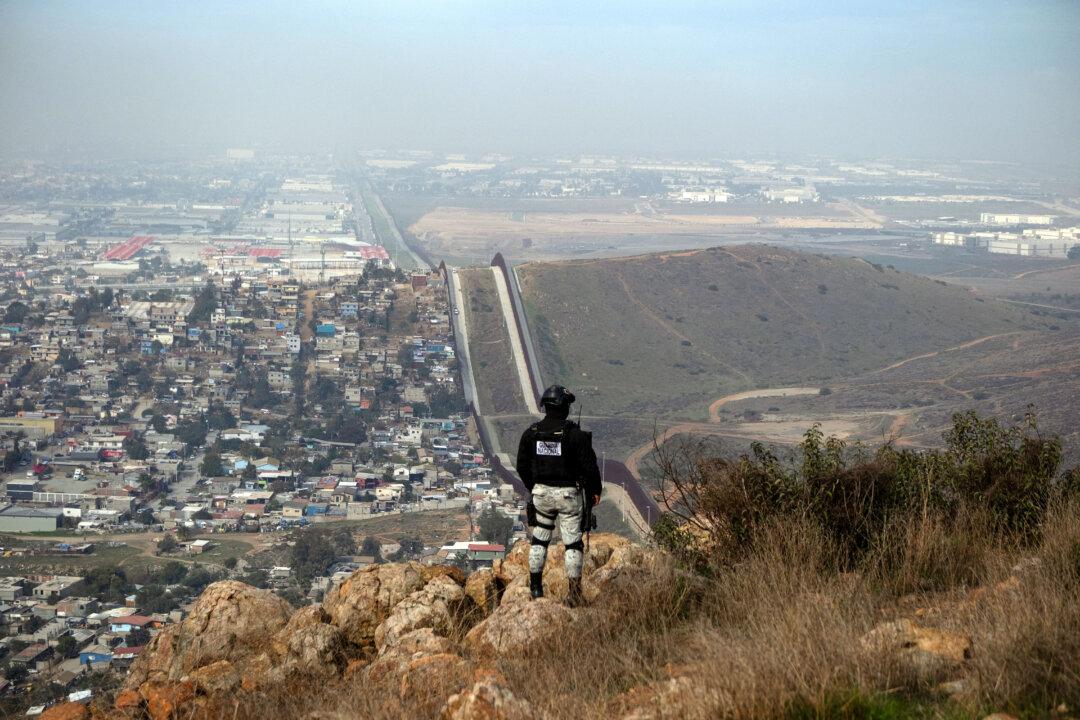‘Restaurant owners are really stuck between a rock and hard place,’ says economist Thomas Savidge.
Fast-food restaurants survive by providing affordable, quick, and convenient meals, but cost inflation is now pushing their business models to the brink.
It has become more expensive to eat out over the past five years, with food away from home increasing by
30 percent, according to the Bureau of Labor Statistics. In just the past year, the cost of eating at a fast-food restaurant has increased by more than that of a full-service restaurant.
Within the consumer price index, the limited-service meals category (food that is ordered at a counter and taken to go)
rose by 4.3 percent year over year in July. By comparison, full-service meals (sit-down restaurants with wait staff) increased by 3.8 percent over the same period.
Mcdonald’s was recently stung by reports that it was charging $18 for a Big Mac, prompting the company’s president to issue an
open letter in May.
“I can tell you that it frustrates and worries me, and many of our franchisees, when I hear about an $18 Big Mac meal being sold—even if it was at one location in the U.S. out of more than 13,700,” McDonald’s USA President Joe Erlinger wrote, noting that the average price of a Big Mac across all U.S. franchises had gone up by 21 percent since 2019, from $4.39 to $5.29 today.
According to a McDonald’s “
myths vs. facts” sheet, the company increased average menu prices by about 40 percent over the past five years, which is in line with the increase in the firm’s costs. Employee salaries have gone up by 40 percent since 2019, and food and paper costs went up by 35 percent during the same period, the company stated.
At some point, however, customers will question the value of fast food, compared to alternatives such as full-service restaurants or eating at home, industry experts say.
“People like going to Subway to grab lunch. It’s cheap, it’s quick, it’s easy, it’s good. But they question whether they want to pay $12.99, or $14.99, for what used to be an $8.99 bundled meal,” Gary Pryor, a former owner of restaurants and food production companies and a business consultant at Waters Business Consulting Group, told The Epoch Times.
According to a
May survey of 2,000 U.S. adults by Lending Tree, price hikes have caused 78 percent of Americans to view fast food as an increasingly unaffordable luxury. And while three-quarters of Americans say they typically eat fast food at least weekly, nearly two-thirds say they are now eating it less due to rising prices.
Chipotle increased menu prices four times between 2021 and 2023, according to an American Institute of Economic Research
report by economists Thomas Savidge and Andrew den Boggende, prompting a backlash from customers who also accused the chain of reducing portion sizes. Viral complaints by diners circulating the internet prompted then-CEO Brian Niccol to assure customers in a
Fortune interview in May that portion sizes had not changed.
Niccol left Chipotle on Aug. 13 to take the helm at Starbucks, which is also struggling. Starbucks reported in its
third-quarter fiscal 2024 results that sales were down by 3 percent, driven by a 5 percent decline in the number of customer transactions, although there was an average 3 percent increase in what each customer paid at the coffee chain.
McDonald’s
reported in July that its quarterly sales were down by 1 percent worldwide and by 0.7 percent in the United States. At the same time, its operating income decreased by 6 percent, indicating the company’s difficulties with both income and expenses.
Getting Squeezed
“Restaurant owners are really stuck between a rock and hard place, whether it’s Chipotle, which doesn’t franchise, or McDonald’s, which does,” Thomas Savidge, a research fellow at the American Institute for Economic Research, told The Epoch Times.
“The last thing they want to do is raise menu prices any more than they have over the past couple of years. But ultimately, there’s going to have to be some painful choices made.”
The more obvious options for fast-food restaurants are higher prices, smaller portions, or less staff, which often means longer lines and a less pleasant dining experience, he said.
The industry is currently racing to figure a way out of the current situation.
McDonald’s CFO Ian Borden said on the company’s April 30 conference call that “everybody’s fighting for fewer consumers or consumers that are certainly visiting less frequently.”
“We’ve got to make sure we’ve got that street-fighting mentality to win,” he said.
Cratering sales led Subway last week to call what was reported to be an “
emergency meeting” of the 19,000 franchisees of its North American sandwich shops to discuss price promotions, discounts, and other ways to increase customer traffic.
The industry is at a “crossroads,” according to Michael Podolsky, CEO and co-founder of an online review platform and consumer advocacy group.
“While these brands remain strong players, consistent issues with customer service, food quality, and pricing are causing consumer dissatisfaction,” Podolsky told The Epoch Times. “Addressing these concerns will be critical for staying strong on the market, otherwise, consumers might switch to a better quality dining experience at similar or slightly higher prices.”
Searching for Solutions
Some restaurants are getting creative in their search for solutions.This includes Taco Bell offering
Happier Hour, when drinks are discounted to bring more customers in during slower hours. It includes customer loyalty programs such as
MyMcDonald’s Rewards, which can award frequent customers points toward free meals.
Wendy’s CEO Kirk Tanner told investors in February that the fast-food chain was considering instituting a “
flexible pricing” system, which would adjust
menu prices based on customer demand, similar to “surge pricing” spikes charged by Uber during rush hour. This sparked protests from customers, as well as accusations from Sen. Elizabeth Warren (D-Mass.) of “price gouging,” prompting Wendy’s to issue a statement saying it wouldn’t implement the practice.
While the fast-food industry looks for solutions to remain profitable as its costs continue to rise, restaurants are being hit by not only escalating costs for food, energy, and materials but also by wage hikes.
Wage expenses are typically between 25 and 30 percent of total costs for fast-food restaurants.
On April 1, California increased the state minimum wage to
$20 per hour for fast-food employees, in a growing trend of states mandating higher labor costs. Currently, 29 U.S. states now have a
minimum wage at or above $10 per hour, according to data collected by the Economic Policy Institute. This compares to the national minimum wage of $7.25 per hour, which has not increased since 2009.
In addition, 15 states now have a minimum wage above $14 per hour, or approximately double the federal rate. Seven states—Alabama, Georgia, Louisiana, Mississippi, South Carolina, Tennessee, and Wyoming—have no state minimum wage, although in those states, the federal minimum applies.
Many restaurants unable to pass these costs on to diners simply close.
Based on data collected from Google maps and tracking the number of locations that were listed as “permanently closed,” a restaurant services company called Snappy calculated that
1,040 fast-food restaurants had closed in California in the four months since the state’s $20 minimum wage took effect, compared to 315 that had closed in 2024 prior to the wage hike.
Other restaurants are looking to invest in automation to increase worker efficiency and cut staffing levels. According to a
February 2023 survey by the National Restaurant Association, 58 percent of restaurant operators said they intended to rely more on automation in the coming years to reduce the need for human workers.
Entry-Level Jobs Going Away
For many lower-skilled or entry-level workers, however, restaurants often provided an entry point into the labor market, allowing them to build skills and experience toward higher-paying jobs.
“Employers are going to be hesitant to take on an unskilled employee and bear the cost of teaching them a skill,” Savidge said. “They’re going to be less willing to take a risk on those new, inexperienced employees who are looking to build up job experience and enter the job market.”
While the inflation growth rate has slowed over the past year, price pressures remain throughout the food industry, which is now also facing an increasingly cost-conscious consumer.
“They’re spending money on their vacations or things, but eating out at fast food is not a valuable proposition for a family of five people when it’s costing $100,” Pryor said.
And beyond the struggle to keep menu prices down, there is the pressure on fast-food restaurants to provide meals with the same speed and efficiency, even as they try to cope with staffing issues.
“Costs don’t always get translated in menu prices,” Savidge said. “Sometimes, the cost is sitting in a really long drive-through line, waiting 20 minutes to just take your order there.
“That in itself is a cost—the value of your time.”








